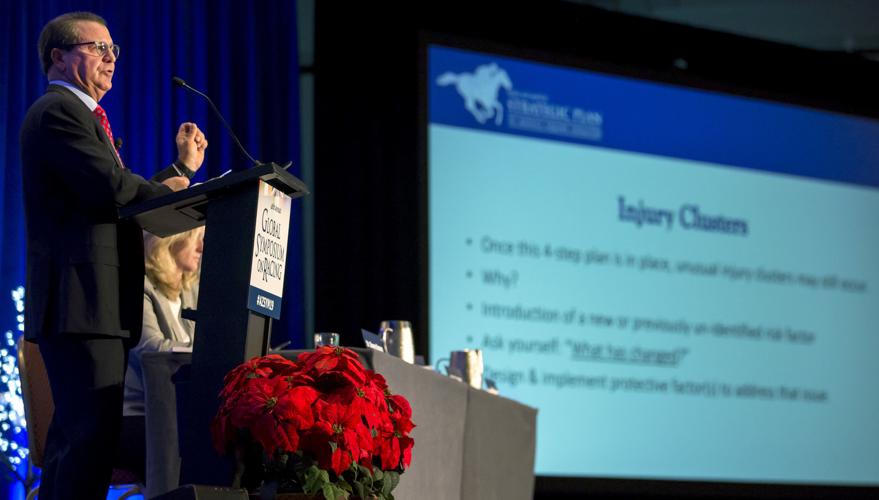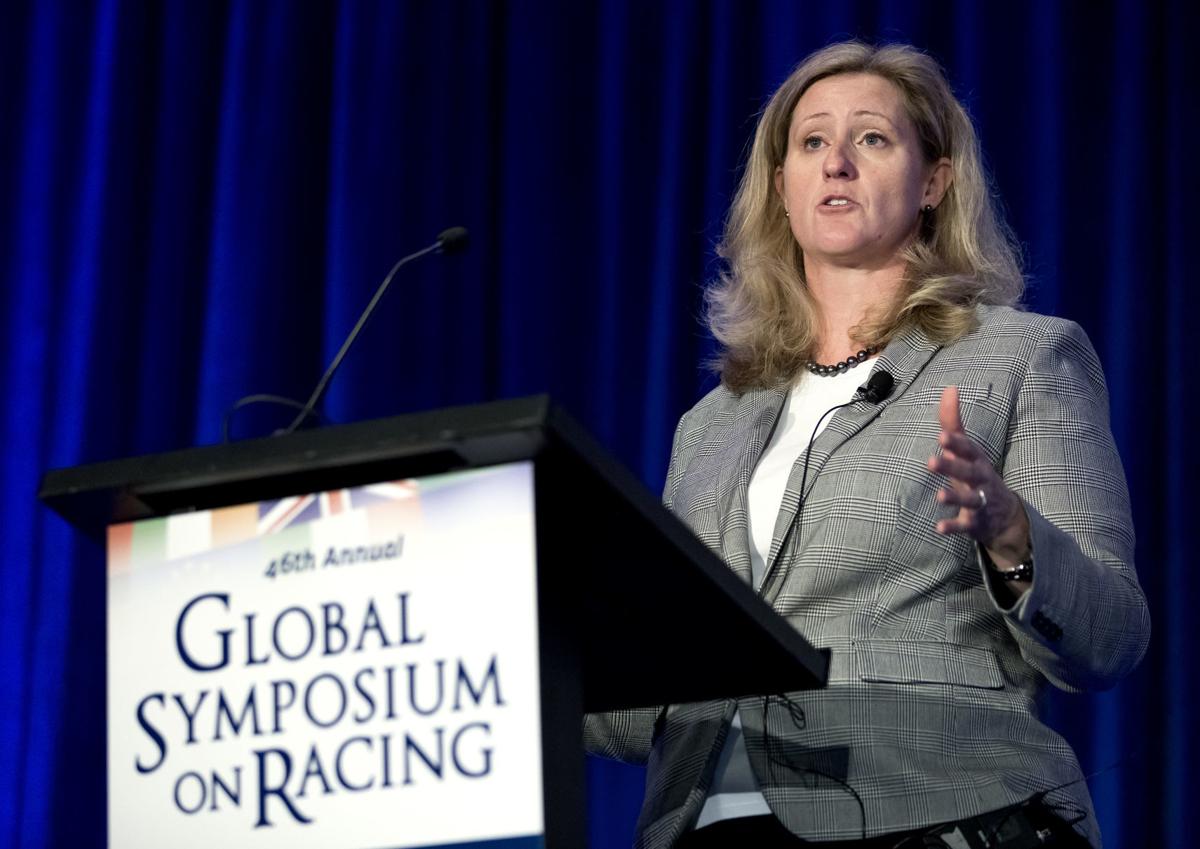Horse racing experts gathered at a Tucson resort on Tuesday to discuss the changes being made throughout the sport after a series of high-profile equine deaths. They all agreed that while improvements and oversight will come at a significant expense, they’re critical to the future of horse racing.
The panel on racing safety and welfare initiatives was one of several offered at the 46th Annual Global Symposium on Racing, a two-day event held at Loews Ventana Canyon.
The symposium is hosted by the University of Arizona’s Race Track Industry Program, widely believed to be among the best in the country.
More than 500 racehorses have died this year, with 24 of the deaths occurring at Turf Paradise in Phoenix, according to The Arizona Republic. Turf Paradise is among the racetracks that are prioritizing the horses’ welfare, whether it’s by checking and maintaining the racing surface, hiring private veterinarians to oversee entries or limiting the medications a horse can take before racing.
Although injuries, some of them fatal, are inherent in horse racing, Tuesday’s panelists agreed the industry can still do better.
The sport’s future depends on it.
“If we don’t make these investments, horse racing will not survive”
As deaths at California’s Santa Anita Park piled up last spring, making national headlines and sparking outrage, the track’s management group realized that it had to act fast, Dr. Dionne Benson, the Stronach Group’s Chief Veterinary Officer, said Tuesday. The Stronach Group oversees Santa Anita and five other racetracks throughout the United States.
Benson said 30 horses have died at Santa Anita since December 2018, and an investigation into their deaths is still in the hands of the California Horse Racing Board and the Los Angeles District Attorney. Deaths are fairly common — 18 horses died at Santa Anita in all of 2018 — but times are changing, and that number of fatalities no longer sits well with the public, Benson said.
In the spring, the Stronach Group took action, creating Benson’s position and rolling out several bold changes in the areas of horse racing and training. New rules limit how many days prior to a race day specific types of medications can be administered.
Jockeys will soon be told when they can — and can’t — use riding crops.
“One of the things that was made abundantly clear was that the public does not like the use of the whip,” Benson said.
Santa Anita and other tracks are also using private veterinarians rather than those traditionally employed by the track. The private vets at Santa Anita decide whether horses can race.
A new five-person governor’s review panel evaluates entries, has the power to “scratch” horses deemed unfit to race and can require others to seek an additional veterinary exam or more review. The new oversights have led to between one and five horses per race being scratched each day, Benson said.
Horses have been dying during training as well, and so similar changes have been made to the training side. Santa Anita brought in new medical technology to quickly and accurately diagnose fetlock injuries, which — while not fatal on their own — often result in euthanasia.
The changes were implemented in April, and the results have been staggering. There have been just six deaths since, a sizable reduction from the 23 fatalities that took place between December 2018 and last March. The track does not include one sudden death that occurred during that time period.
“We can no longer say it’s a financial disincentive to save that horse and do that surgery,” Benson said.
“We have to spend the money. Every horse has to be treated if it can have a comfortable and humane retirement.”
The Stronach Group has invested $500,000 in medical technology at Santa Anita, part of a $3 million project.
The group is also spending close to $1 million per region on veterinary staffing, Benson said.
The Stronach Group is still looking at new ways to improve horse health and safety, as should other industry professionals, Benson said, since the events that happened at Santa Anita could easily happen at any other track.
“If we don’t make these investments, horse racing will not survive,” Benson said.
“For the integrity of our product, … we had to do the right thing”
If the events at Santa Anita represented the worst moments for horse racing in 2019, the resurrection of the once-shuttered Colonial Downs Racetrack in Virginia was no doubt the bright spot. The track had been closed for six years before it reopened in August.
“It didn’t happen by accident. A lot went into bringing racing back to the state of Virginia,” said Jill Byrne, the track’s vice president of racing operations.
Byrne was proactive when she arrived at Colonial Downs. She started by setting fire to the track’s famous turf, freeing up the soil so it could absorb much-needed nutrients.
“Everything starts for me with the surface, because that’s where your horses are running,” Byrne said. Colonial Downs also implemented pre-race and race day protocols; it also brought in state-employed veterinarians.
The veterinarians “flag” horses that show warning signs, keeping them from racing or training.
“For the integrity of our product, especially being a new product, we had to do the right thing,” Byrne said. “We didn’t have the luxury of starting off on the wrong foot.”
Like Santa Anita, Colonial Downs implemented new rules about medication and crop use. Track stewards spoke to the jockeys before each race to let them know Colonial Downs’ expectations and what would be tolerated, Byrne said.

Alan Foreman, chairman and CEO of Thoroughbred Horseman’s Association, talks about the “Mid-Atlantic Strategic Plan to reduce equine fatalities” during a speakers panel on horse racing safety at the University of Arizona’s 46th annual Global Symposium on Racing at Loews Ventana Canyon Resort, 7000 N. Resort Dr., Tucson, Ariz. on December 10th, 2019. Speakers informed attendees about the health risks involved in horse racing, such as veterinary care and poor race tracks, and how those problems could be fixed.
The proactive approach and attention to detail paid off: There were zero fatalities at Colonial Downs during its inaugural season, which ran from Aug. 10 through Sept. 7.
“A lot of that could be based upon luck,” Byrne conceded. “But a lot of hard work went into this.”
“Our top priority is the safety and welfare of the horse”
This isn’t the first rash of horse deaths in the sport. But experts are hoping it can be the last.
Alan Foreman, CEO and chairman of the Thoroughbred Horsemen’s Association, talked Tuesday about the fatalities that occurred during the 2011-12 racing season at Aqueduct racetrack in New York. He was part of a three-person panel charged with investigating 21 horse deaths there; the panel came up with 38 reform recommendations that were adopted by the state, and then by the mid-Atlantic thoroughbred racing industry.
Between 2013 and 2018, there was a 35% reduction in fatalities in the mid-Atlantic region, Foreman said. This spring, the Mid-Atlantic Strategic Plan to Reduce Equine Fatalities, modeled after the 2012 task force report, was enacted. It addresses veterinary practices and procedures, adopts a mortality review board, develops protocols for racing surface and weather monitoring and adopts medication regulations and testing, among other things. A coalition of 35 organizations have committed to the strategic plan, including each of the seven state’s racing commissions and all participating racetracks, Foreman said.
“Our top priority is the safety and welfare of the horse,” Foreman said. “I feel good about what we’re doing in the mid-Atlantic and I feel good about what we’re doing in the industry.”
The deaths at Santa Anita reminded the public of the risks inherent in horse racing.
While the fatality rate per start equates to roughly 0.2%, that number is still too high, Foreman said.
“Will we ever get to zero? I don’t know, but we can certainly do better,” Foreman said.






